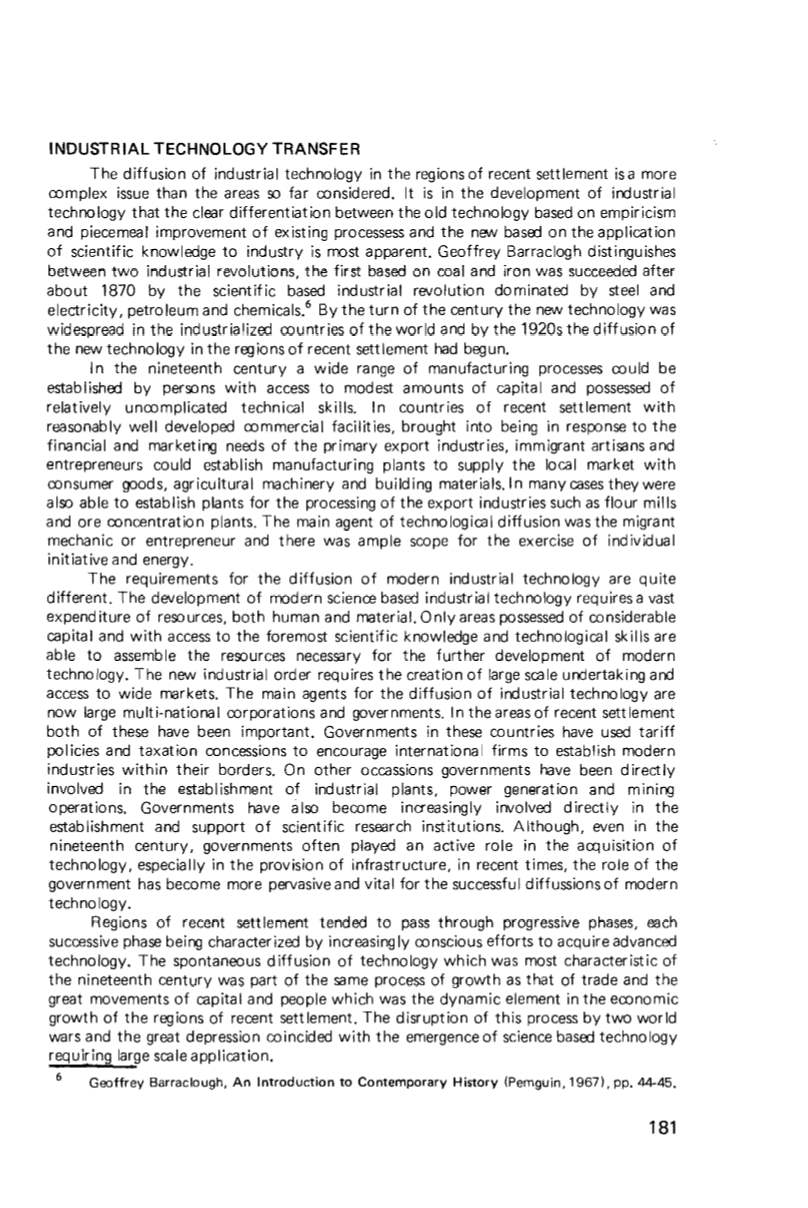
INDUSTRIAL TECHNOLOGY TRANSFER
The diffusion of industrial technology in the regionsof recent settlement isa more
complex issue than the areas so far considered. It is in the development of industrial
technology that the clear differentiation between the old technology based on empirícism
and piecemeal improvement of exísting processess and the nfNJ basocl on the application
of scientific knowledge to industry is most apparent. Geoffrey Barraclogh distinguishes
between two industrial revolutions, the first based on coa I and ¡ron was succeeded after
about 1870 by the scientific based industrial revolution dominated by steel and
electricity, petro leum and chemicals.
6
By the turn of the century the nfNJ technology was
widespread in the industrializocl countries of the world and by the 1920s the diffusion of
the new technology in the regions of recent settlement had begun.
In the nineteenth century a wide range of manufacturing processes could be
established by persons with access to modest amounts of capital and possessed of
relatively uncomplicated technical skills. In countries of recent settlement with
reasonably well developed commercial facilities, brought into beíng in response to the
financial and marketing needs of the primary export industries, immigrant artisans and
entrepreneurs could establish manufacturing plants to supply the local market with
consumer goods, agricultural rnachinery and building materials.ln manycasestheywere
also able to establish plants tor the processing of the export industries such as flour milis
and ore concentration plants. The main agent of technologi03I diffusion was the migrant
mechanic or entrepreneur and there was ample scope for the exercise of individual
initiative and energy.
The requirements for the diffusion of modern industrial technology are quite
different. The development of modern science based industrial technology requiresa vast
expend iture of resources, both human and material. Only areas possessed of considerable
capital and with access to the foremost scientific knowledge and technologi03I skills are
able to assemble the resources necessary for the further development of modern
technology. The nfNJ industrial order requires the creation of large s03le undertaking and
access to wide markets. The main agents for the diffusion of industrial technology are
now large mult i-nationa I corporations and governments. In the areas of recent sett lement
both of these have been important. Governments in these countries have used tariff
policies and taxation concessions to encourage international firms to establish modern
industries within their borders. On other occassíons governments have been directly
involved in the establishment of industrial plants, power generation and mining
operations. Governments have also become increasingly involved directly in the
establishment and support of scientific research institutions. Although, even in the
nineteenth century, governments often played an active role in the acquisition of
technology, especially in the provision of infrastructure, in recent times, the role of the
government has become more pervasiveand vital for the successful diffussionsof modern
technology.
Regions of recent settlement tended to pass through progressive phases, each
successive phase being character ized by increasing Iy co nscious efforts to acqu ire advanced
technology. The spontaneous diffusion of technology which was most characteristic of
the nineteenth century was part of the same process of growth as that of trade and the
great movements of capital and people which was the dynamic element in the economic
growth of the regions of recent settlement. The disruption of this process by two world
wars and the great depression coincided with the emergenceof science based technology
requiring large scale application.
6
Geoffrey Barraclough,
An
Introduction to Contemporary History (Pemguin, 1967). pp. 44-45.
181


